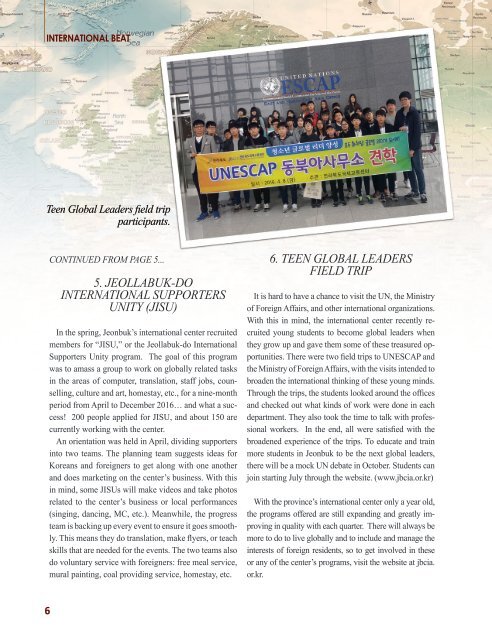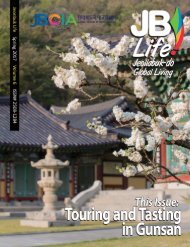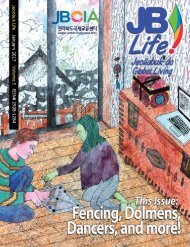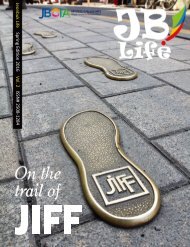JB Life Summer Vol. 3
The summer issue of JB Life, Jeollbauk-do's English magazine, covering July-September.
The summer issue of JB Life, Jeollbauk-do's English magazine, covering July-September.
You also want an ePaper? Increase the reach of your titles
YUMPU automatically turns print PDFs into web optimized ePapers that Google loves.
INTERNATIONAL BEAT<br />
HISTORY<br />
Teen Global Leaders field trip<br />
participants.<br />
6<br />
CONTINUED FROM PAGE 5...<br />
5. JEOLLABUK-DO<br />
INTERNATIONAL SUPPORTERS<br />
UNITY (JISU)<br />
In the spring, Jeonbuk’s international center recruited<br />
members for “JISU,” or the Jeollabuk-do International<br />
Supporters Unity program. The goal of this program<br />
was to amass a group to work on globally related tasks<br />
in the areas of computer, translation, staff jobs, counselling,<br />
culture and art, homestay, etc., for a nine-month<br />
period from April to December 2016… and what a success!<br />
200 people applied for JISU, and about 150 are<br />
currently working with the center.<br />
An orientation was held in April, dividing supporters<br />
into two teams. The planning team suggests ideas for<br />
Koreans and foreigners to get along with one another<br />
and does marketing on the center’s business. With this<br />
in mind, some JISUs will make videos and take photos<br />
related to the center’s business or local performances<br />
(singing, dancing, MC, etc.). Meanwhile, the progress<br />
team is backing up every event to ensure it goes smoothly.<br />
This means they do translation, make flyers, or teach<br />
skills that are needed for the events. The two teams also<br />
do voluntary service with foreigners: free meal service,<br />
mural painting, coal providing service, homestay, etc.<br />
6. TEEN GLOBAL LEADERS<br />
FIELD TRIP<br />
It is hard to have a chance to visit the UN, the Ministry<br />
of Foreign Affairs, and other international organizations.<br />
With this in mind, the international center recently recruited<br />
young students to become global leaders when<br />
they grow up and gave them some of these treasured opportunities.<br />
There were two field trips to UNESCAP and<br />
the Ministry of Foreign Affairs, with the visits intended to<br />
broaden the international thinking of these young minds.<br />
Through the trips, the students looked around the offices<br />
and checked out what kinds of work were done in each<br />
department. They also took the time to talk with professional<br />
workers. In the end, all were satisfied with the<br />
broadened experience of the trips. To educate and train<br />
more students in Jeonbuk to be the next global leaders,<br />
there will be a mock UN debate in October. Students can<br />
join starting July through the website. (www.jbcia.or.kr)<br />
With the province’s international center only a year old,<br />
the programs offered are still expanding and greatly improving<br />
in quality with each quarter. There will always be<br />
more to do to live globally and to include and manage the<br />
interests of foreign residents, so to get involved in these<br />
or any of the center’s programs, visit the website at jbcia.<br />
or.kr.<br />
By STUART SCOTT<br />
Jeonbuk <strong>Life</strong> Contributing Writer<br />
There are many folk tales dealing with plants and<br />
flowers. The ancient Greeks and Romans believed<br />
parsley was a symbol of death and rebirth.<br />
Achemorus, a Greek hero, was killed by a serpent. Legend<br />
says that a parsley plant sprang up from his blood. Greeks<br />
would put parsley on tombs of loved ones, hoping for their<br />
rebirth. If someone was near death, people would say they<br />
needed parsley.<br />
In Kenya, the God Ruwa made people immortal but instructed<br />
them not to eat any yams. One day “death” convinced<br />
the people to cook the yams for him. However, when the God<br />
Ruwa realized what they had done, he took away their immortality.<br />
The violet also has a place in mythology. Attis was killed by<br />
a wild boar. On the places where his blood fell, legend says<br />
that violets grew. This story is of special interest because it<br />
has a similar theme to the Dongbaek flower.<br />
When I first heard of the legend of Dongbaek, I was told<br />
that it was a story of a young couple. The husband went to<br />
war and never returned. The flower grew from the blood of<br />
his wife. However, when trying to get more details of this<br />
story, I came across three others, and I believe there are more.<br />
The first one is a story of a poor young fishing couple on<br />
Daechong Island. One day, the husband returned to his home<br />
village to attend to his ill parents. Every day, his wife went to<br />
the sea, waiting for her husband’s return. He stayed with his<br />
sick parents for a long time. When he finally did return, his<br />
wife had died. He went to her grave, and his tears watered a<br />
Dongbaek seed. A tree grew on this spot the following spring.<br />
The second story also involved a young fishing couple.<br />
While the husband was out fishing, a thief entered their home.<br />
He tried to kill the young bride, but she ran away. While looking<br />
for her husband, she fell off a high cliff. Her husband<br />
found her and buried her there. Legend says the Dongbaek<br />
flower grew from her grave.<br />
The final story is one of a childless king. His younger brother<br />
had children, and thus the king’s nephew was heir to the<br />
throne. The king did not like this arrangement, and he planned<br />
to kill his nephew. However, the king’s brother tricked the<br />
King, putting his adopted sons in the place of his real sons.<br />
The two adopted sons, according to the legend, turned into<br />
birds and flew away. When the younger brother was buried,<br />
the Dongbaek flower grew from his grave.<br />
“Camellia” is the English name for the Dongbaek flower.<br />
This flower has economic importance as it is used in the<br />
making of tea. Today, many camellias are grown more for<br />
ornamental value. Depending on location, the colour may<br />
be red, white, yellow or pink. The Dongbaek legend appears<br />
to have its roots in Jeollanamdo or Jejudo. However, if one<br />
wants to see this beautiful flower, one does not need to leave<br />
the province. Seonunsa temple, near Gochang, has many of<br />
these flowers. The temple itself was first built in 577 AD. Of<br />
course, it has since been burned by the Japanese and rebuilt.<br />
The temple also has many other cultural properties, but behind<br />
the temple is a forest of camellia trees. They are estimated<br />
to be 500 years old and have been designated as a natural<br />
monument. Dongbaeks are green year round but flower in the<br />
late winter or very early spring. This makes Seonunsa an ideal<br />
destination for that season.<br />
There are always reasons for some to find fault with folktales,<br />
but regardless, it is without dispute that the Dongbaek<br />
flower has a special place in history and will be forever cherished<br />
for its beauty.<br />
* Flower photo above licensed under Creative Commons by SA-2.0,<br />
with original credit to Flickr user juantiagues.<br />
Jeonbuk <strong>Life</strong> 7







